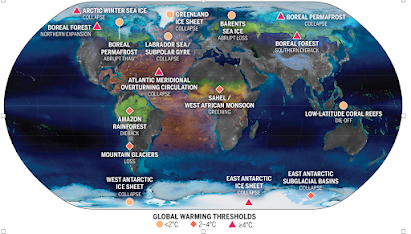Tipping points and the Earth's climate - how do we model the risk?
In April, the IPCC published the next installment of reports on the state of the planet. Several alarms on the state of the planet were sounded - and yet, most researchers were concerned that the report did not go far enough. Why was that?
One of the challenges with synthesizing science across multiple areas and bringing it to the point where policy makers can make decisions that follow the science is that the latest research often doesn’t make it into these reports. That’s because the research is cutting-edge, which by definition means that new discoveries are happening and the science is not yet at the point where clear recommendations can be made. Second, with cutting-edge science, researchers are still discussing the nitty-gritty details of what the processes are, what’s driving them and how the system is functioning. That makes it much more difficult to reach a scientific consensus on the topic.
So, what is one such area of cutting edge research in climate science? Climate change tipping points (CTP) - or the points at which the Earth’s climate system shifts from one state to another - is an example.
About 20 years ago when it started becoming clear that the Earth’s climate was changing, scientists asked a crucial question - how long has the Earth’s climate been in a certain state? On the face of it, that sounds like a fairly simple question - but in reality, it leads to several other questions and finally generated a scientific area of its own. For example, what are the main processes or levers that contribute to the Earth’s climate? How stable is the Earth’s climate - in other words, does it often oscillate around some point and then return after the oscillations are removed or is there more than one possible stable state? How long do different states of the Earth’s climate last? And most critically, are there certain conditions where the climate could move from one state to another - and what are those conditions?
Scientists examined records from tree-rings, ice cores and used other methods to understand what the Earth’s climate would have looked like over several million years. This particular field is known as “paleo-climatology”. From these records, they realized that over the long history of the Earth, there have been several different climate states, all of which were stable until there was a dramatic change in some conditions. These conditions are called “tipping points”.
How does that impact humanity and the other species living on our planet? That’s where the questions related to tipping points became more focused. First, how many of these tipping points are there and what is the current state? Second, if any of them change, how does that influence the other tipping points and other states of the climate?
In 2008, researchers identified nine possible tipping points that could have significant impacts on Earth’s climate. These include the melting of Greenland and Arctic ice sheets and Amazon forest dieback among others. Last year, scientists increased the list to sixteen and identified the temperature thresholds at which these points are likely to be activated (Figure 1). These points were identified as the major drivers of the Earth’s climate on either a regional or global scale from climate models.
What does that mean? At this point, the Earth’s climate is on the way to exceed 1.5oC warming, unless we take drastic action over the next five years and this may trigger several tipping points.
To quote the scientists in the study “Five of the sixteen may be triggered at today's temperatures: the Greenland and West Antarctic ice sheets, widespread abrupt permafrost thaw, collapse of convection in the Labrador Sea, and massive die-off of tropical coral reefs. Four of these move from possible events to likely at 1.5°C global warming, with five more becoming possible around this level of heating.”
By triggering the tipping points, it is likely that some of the Earth’s processes will move from one stable state to another. One crucial question that the scientific community is still researching is how quickly that change can happen - and what the impacts are going to be on humanity and our other ecosystems. A second question that needs answering is how the tipping points cascade - that is, triggering some of the tipping points may trigger the others - which in turn can shift the Earth’s climate from one stable state to another.
In some cases, the change may be irreversible - that is, once the tipping point is triggered, the change will continue regardless of what is done about emissions. That means even if temperature stops rising, once the ice sheet, ocean or rainforest has passed a tipping point it will carry on changing to a new state. How long the transition takes varies from decades to thousands of years depending on the system. For example, ecosystems and atmospheric circulation patterns can change quickly, whilst ice sheet collapse is slower but leads to unavoidable sea level rise of several meters.
While we still have time to mitigate our emissions, we also need to examine what human societies will have to do to adapt to the changes that are coming our way.
Figure 1: Tipping points and their temperature thresholds (Source: McKay et al 2022, Science)


